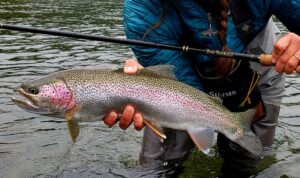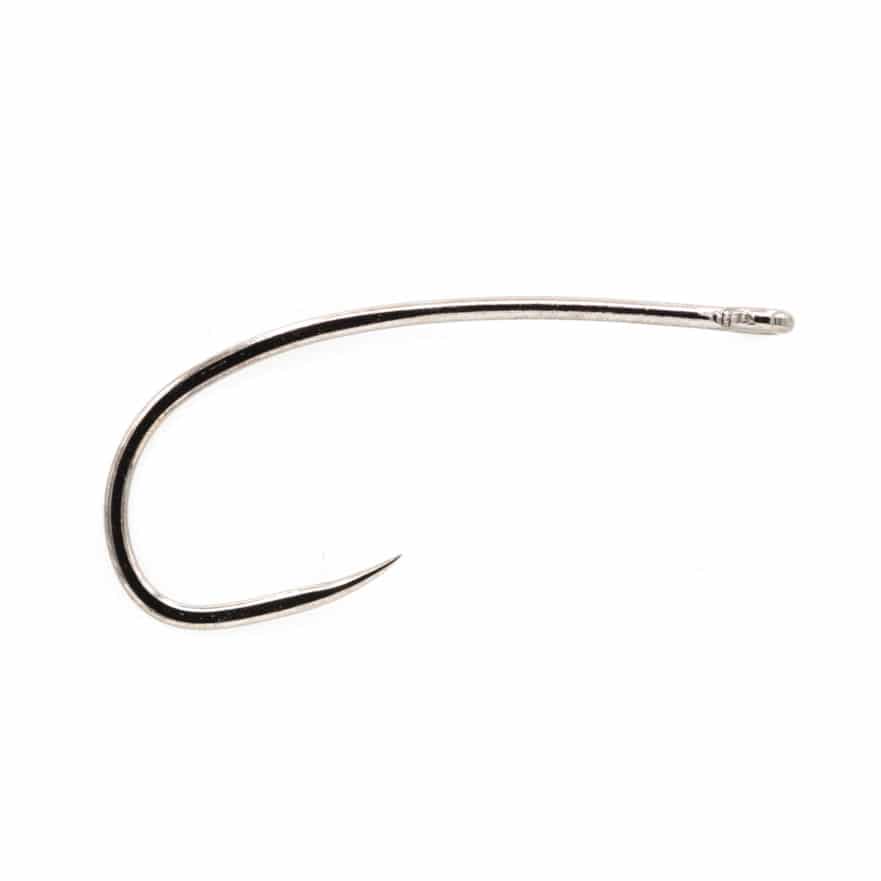
- What type and length of line are you using? “I’m using an 8-ft level line (like a 2-wt level floating fly line, with about a foot of orange indicator mono and then a 2.5-3 ft 4-5x tippet; I usually fish the rod in its 2nd position.”
- How are you setting the hook? From up high or to the side? “I usually try to set up high (vertically) not horizontally.”
- Are you keeping pressure and tension on the line after the hookup? “Yes, and sometimes it feels like I use too much pressure and that this rips the hook out of the fish’s mouth; possibility?”
- Is the fish running towards you? ” No, they generally stay in the current and try to keep away from me, who is applying the line tension.”
- How are you setting the hook – Are you possibly “dragging” the line or pulling to set the hook rather than “popping” it? “This is certainly a possibility, maybe I need a firmer “pop” set?”
- What size hook are you using? “Pretty much 12s, but sometimes 14s, but no smaller.”

His line and setup sounded fine. Frankly, line shouldn’t really matter except that it can impact how you set a hook. If you are keeping things tight and off the surface of the water as in traditional tenkara, there is no slack in the line and the hookset is easy. Since the line is tight, the fish practically sets itself when it takes the fly. All an angler needs to do is “secure” the hook with a small “pop” of the wrist.

The longer the line you cast, the more focused you need to be about reducing slack and keeping the line tight – even though it may be long. The longer the line you use, the greater the probability that it is laying on the surface of the water. The more line you have on the surface of the water, the more surface tension and friction you have to overcome in order to set the hook. Not only do you have surface tension and friction to overcome, there simply is more weight to move. More means more. In this scenario, to get a solid hook set, your movement must go from a small wrist “pop” to a wrist pop combined with arm motion. These combined movements allow you to move more line, move more weight and move it swiftly.
Keep in mind, when you set a hook on a tenkara rod, you’re not only securing the hook, but you’re also compensating for the bend which will occur in the rod’s soft, flexible tip section. On a tight-line setup, the “pop” of the wrist essentially does just that – it compensates for the tip bending. On a long-line setup however, the wrist “pop” and a quick arm movement (just a small, short but quick drawback) is required to secure the hook as well as compensate for the soft, flexy, bendable tenkara tip. On a regular fly rod, with a much stiffer tip, drawing your fly rod up and stopping the line in that familiar “trout-set” position, is enough to set the hook, even small hooks with small gaps, since there is minimal flex in the tip. On a tenkara rod this alone is often inadequate.
To this end, when using a tenkara rod, I advise hook setting and playing fish to the side, instead of setting vertically, as you would with a regular fly rod. Aim for about 45 to 65 degrees off the surface of the water, and to the side. This upward, side position helps anglers utilize the lower, stronger sections of their tenkara rod, creates a broader, more even curve in their rod and eliminates scenarios in which fish are only being played (or attempted to be played) on the soft tip sections. This upward, to the side rod position will still keep the fish’s head high, reducing the chance of a run.

Imagine a candy cane. They don’t resemble the letter “C” or a half circle. They look more like and upside-down letter “J”. A candy cane is straight and bends or curves only in the upper 1/4th of its total length. “Candy caning” your tenkara rod means putting your tenkara rod into a candy cane position in which the majority of your rod is straight and only the top few sections are flexing. Doing this regularly results in the application of uneven, intermittent pressure on the fish, and your rod, which can lead to several frustrating outcomes: As the fish struggles and the tenkara tip flexes and bounces, there are moments when there’s slack in the line. During these moments the fish can throw the hook. This flexing and bouncing can also cause the tippet to break, also losing the fish. Worse yet, is when that uneven pressure causes that ultrathin tenkara rod tip to break. Applying steady, even, consistent pressure on the fish is how to maintain the connection, take control and reduce fish loss. Remember the mantra: No Candy Canes.

Fishing in general is not easy. If it were, it would lose some of its attraction. We fish and gain pleasure from the sport because it’s challenging and rewarding, when we succeed. Everybody loses fish. But there are things we can do to reduce the likelihood of it happening often. Best practices just increase our odds of staying connected, of bettering the odds if you will. Setting hooks and playing fish up and to the side will help your hook sets be more solid. It will allow you to keep even steady pressure on the fish and will reduce the bounciness that comes with playing vertically. Simply put, these few suggestions will help you stay connected, reduce thrown hooks, reduce tippet breaks and will help you avoid rod breaks in the future. Even better, you will have more successful landings.
Your thoughts are always welcomed and appreciated. And please let me know if these suggestion work for you.



